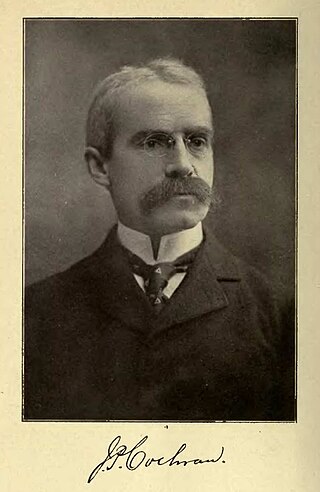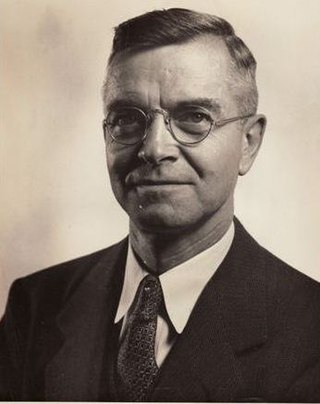
Joseph Plumb Cochran, M.D., was an American Presbyterian missionary and medical doctor. He is credited as the founding father of Iran's first modern Western medical school, Westminster College in 1879.

Pandita Ramabai Sarasvati was an Indian Social Reformer. She was the first woman to be awarded the titles of Pandita as a Sanskrit scholar and Sarasvati after being examined by the faculty of the University of Calcutta. She was one of the ten women delegates of the Congress session of 1889. During her stay in England in early 1880s she converted to Christianity. After that she toured extensively in the United States to collect funds for destitute Indian women. With the funds raised she started Sharada Sadan for child widows. In the late 1890s, she founded Mukti Mission, a Christian charity at Kedgaon village, forty miles east of the city of Pune. The mission was later named Pandita Ramabai Mukti Mission.

Samuel Marinus Zwemer, nicknamed The Apostle to Islam, was an American missionary, traveler, and scholar. He was born at Vriesland, Michigan. In 1887 he received an A.B. from Hope College in Holland, Michigan, and in 1890, he received an M.A. from New Brunswick Theological Seminary in New Brunswick, New Jersey His other degrees include a D.D. from Hope College in 1904, a L.L.D. from Muskingum College in 1918, and a D.D. from Rutgers College in 1919.

The Southern Asia Division (SUD) of Seventh-day Adventists is headquartered at Hosur, Tamil Nadu, India. It heads the activities of the Seventh-day Adventist Churches and its affiliated bodies in India, Nepal and Bhutan.The Division has 1,143,346 members as of June 30, 2021.
Medical missions in China by Protestant and Catholic physicians and surgeons of the 19th and early 20th centuries laid many foundations for modern medicine in China. Western medical missionaries established the first modern clinics and hospitals, provided the first training for nurses, and opened the first medical schools in China. Work was also done in opposition to the abuse of opium. Medical treatment and care came to many Chinese who were addicted, and eventually public and official opinion was influenced in favor of bringing an end to the destructive trade. By 1901, China was the most popular destination for medical missionaries. The 150 foreign physicians operated 128 hospitals and 245 dispensaries, treating 1.7 million patients. In 1894, male medical missionaries comprised 14 percent of all missionaries; women doctors were four percent. Modern medical education in China started in the early 20th century at hospitals run by international missionaries.
The International Service Fellowship, more commonly known as Interserve, is an interdenominational Protestant Christian charity which was founded in London in 1852. For many years it was known as the Zenana Bible and Medical Missionary Society and it was run entirely by women.

John Anderson (1805–1855) was a Scottish missionary and the founder of the mission of the Free Church of Scotland at Madras, India.
Robert Clark (1825–1900), and his colleague Thomas Henry Fitzpatrick, were the first English Church Mission Society (CMS) missionaries in the Punjab. Clark was the first missionary to the Afghans, and was the first agent of the Church to enter the city of Leh.
The Delhi Female Medical Mission (DFMM) was a medical mission in Delhi, India that was founded in the mid-19th century by an Indian-born Englishwoman named Priscilla Winter. The organization started as a dispensary along the Yamuna River in Delhi, but over time developed into a mission, which was then established as St. Stephen's Hospital for Women and Children, a hospital that remains in operation today.

Victor Clough Rambo was an American medical missionary and ophthalmologist who worked in India from 1924 to 1974 for the United Christian Missionary Society, of which the former Foreign Christian Missionary Society became part in 1920. In India, Rambo served as the medical director of the Christian Hospital Mungeli and initiated the development of eye camps, groups of medical surgeons that visited towns, set up cataract removal stations, and restored sight to the partially blind through eye surgeries. Under Rambo's leadership, the hospital conducted over 150 eye camps in over 25 villages. It is estimated that the implementation of these eye camps helped restore sight to over 40,000 patients.

The zenana missions were outreach programmes established in British India with the aim of converting women to Christianity. From the mid 19th century, they sent female missionaries into the homes of Indian women, including the private areas of houses - known as zenana - that male visitors were not allowed to see. Gradually these missions expanded from purely evangelical work to providing medical and education services. Hospitals and schools established by these missions are still active, making the zenana missions an important part of the history of Christianity in India.

Zenas Sanford Loftis was an American physician who worked briefly as a medical missionary in Batang, a largely Tibetan town in Sichuan Province of West China. His photography and published diary contained accounts of culture, religious traditions, and the geography of China and Tibet.
Winifred Heston, M.D., was a Presbyterian medical missionary who worked in India with the Foreign Missionary Society of the Presbyterian Church in the U.S.A. Heston attended medical school at Laura Memorial Women’s Medical College of Cincinnati and was an associate physician at the General Hospital in Miraj, India, from 1903 to 1907. She performed over five hundred surgical operations during her service in Miraj.
John Fordyce (1819–1902) was a Christian missionary, evangelical minister and administrator who launched the female education initiative in India known as the Zenana Missions. He has been credited with introducing the rickshaw to India.

Benjamin Henry Arthur Margoschis was a Protestant Christian missionary in India. He served the Society for the Propagation of the Gospel in Foreign Parts (SPG) as an overseas missionary in India. The inhabitants of Nazareth, a small town in Tamil Nadu, called him the "Father of Nazareth" and Margoschis Aiyar. Aiyar means clergyman in the native language. Reverend Margoschis was responsible for the development of the small town of Nazareth, which is situated at the southern part of Tamil Nadu, India.

Margaret Brown (1887–1978) was a Canadian nurse and author who worked in clinics in China, created schools for girls and women, taught Chinese nurses, built houses, did religious missionary work, and worked for the Christian Literature Society in Shanghai. She also founded The Women’s Star magazine.

Kali Charan Chatterjee D. D. (1839–1916), also spelt as Kali Charan Chatterji or K.C. Chatterjea, was a Bengali Christian missionary who worked with the American Presbyterian Mission in Hoshiarpur, Punjab and served as the first moderator of the Presbyterian Church in India upon its formation in 1904.

Mary Reed (1854-1943) was an American Christian missionary to India. For the first ten years of her career, she worked as a school teacher in her home state of Ohio. In 1884, she went to India as a missionary of the Cincinnati Branch of the Woman's Foreign Missionary Society of the Methodist Episcopal Church, and entered upon zenana missions work at Cawnpore. In 1890, she became conscious of a strange physical disability, and thinking that her health was failing, returned to the U.S. on a furlough. While recovering in Cincinnati came the dread suspicion and subsequent discovery that the malady was leprosy. At first, she was overwhelmed with the realization, but she quickly decided to give her life to work among the lepers in India, and her thoughts turned to Pithoragarh, among the foothills of the Himalayas, at the base of Chandag Heights, where a group of lepers lived in whom she had already become interested. Her suspicions as to the nature of her disease were confirmed by every specialist she consulted. She kept the diagnosis a secret, however, from her family, with the exception of one sister, and returned to India in 1891. Proceeding to Pithoragarh, Reed informed her family and friends by letter of her purpose, and her reason for choosing this service. Thereafter, she conducted her important work at Chandag, and built up an institution which in many respects was a model of order and well-arranged facilities. Reed continued to work among the lepers of India until her death in 1943. She was a recipient of the Kaisar-i-Hind Medal.
Women's missionary societies include a diverse set of scopes, including medical, educational, and religious. Societies provide services in-country and in foreign lands.











